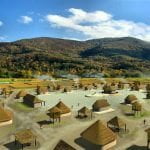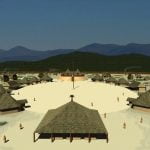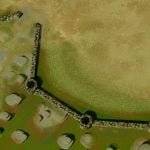In the year 2000 the district office of the U. S. Forest Service in Gainesville, GA contracted with South African archaeologist Johannes Loubser to study the Track Rock Petroglyphs. Loubser operates under the professional name of Stratum Unlimited, LLC. At the time, he was considered an expert of South African art and petroglyphs. In 2001 the Track Rock Alliance citizens group and the Eastern Band of Cherokee Indians provided funds for Loubser to conduct an archaeological survey of the field stone structures on the east side of Track Rock Gap. Laboratory analysis of the soil, charcoal and potsherds in two test pits was conducted by New South Associates, Inc. of Stone Mountain, GA. Loubser’s published paper on the Track Rock survey was co-authored by Dr. Douglas Frink of Worcester State College in Massachusetts.
- Download a PDF of the Loubser and Frink article: Appraisal of a Piled Stone Feature Complex
It is not clear whether the funds from the Eastern Band of Cherokee Indians were provided directly to the Track Rock Alliance or through the Blairsville-Union County Chamber of Commerce. The Eastern Band of Cherokees in the past has donated $1000 a year to the Chamber of Commerce to encourage promotion of the North Carolina reservation as a regional tourist destination.
The survey consisted of a hand sketched site plan and two test pits. One pit was dug along the edge of a field stone retaining wall and agricultural terrace. The other pit was under a section of a fieldstone cairn. However, the laboratory analysis of the soil samples was very comprehensive and met professional standards for precision. These lab tests turned out to be the most important information derived from the survey.

As stated in The Track Rock Terrace Complex, after reading the first few paragraphs of the published paper, I jumped to the tables of radiocarbon dates and then to the site plan. I was hoping to find the telltale footprints of 17th century European structures. They were not there, and the radiocarbon dates were far too early to be associated with Spanish colonial activities. The site plan intrigued me though. It did not look like anything I had seen in the Southeastern United States and very much like Itza Maya terrace complexes that I had visited in the State of Chiapas, Mexico. I went back to the reports and plans prepared by Mr. Loubser and studied the details more thoroughly.
The sketched site plan in the Loubser report thoroughly confused me and was not very legible. I first contacted the staff archaeologist at the Chattahoochee National Forest District Office and asked him for a more legible copy of the site plan. He said that they did not have a copy of the site plan. Without an accurate scaled site plan, I couldn’t do the things I normally do at archaeological and historical sites.

At that point, I decided to create an accurate digital site plan of my own, using CADD (Computer Aided Design and Drafting) and digitized topographic date from the U. S. Geological Survey. I then went back to the slope rising above Track Rock Gap Branch with a precise military compass, a sight level, a laser measuring device and a 100 ft. measuring tape. The laser device is accurate to 1/100,000th of an inch at 500 feet. I found more stone retaining walls and also terraces cut into the earth. I also found what appeared to be channels and water storage basins.
None of these manmade features were shown on the Loubser site plan or discussed in the text. Conversely, I could not find any of the features shown on Loubser plan on the side of the mountain. The Stratum Unlimited, LLC topographic lines did not match available topographic maps of the Track Rock Area.
After several months of consternation, I finally realized that the graphic scale on the site plan in the Loubser Report was not accurate. I should be looking for ruins that were higher on the mountain. The Track Rock archaeological zone extended 500 feet higher in elevation than I had initially assumed.

As for the difference between actual topography and the site plan’s topography, I have no explanation. Furthermore, the community sponsored archaeological survey evidently did not include the lower 200 feet of the mountain slope. The manmade features in this part of the archaeological zone were just not on the published site plan.
The text in the Track Rock report begins with a general discussion of some of the enigmatic rock structures in northern Georgia, eastern Tennessee and western North Carolina. The best known are at Fort Mountain State Park near Chatsworth, GA and Old Stone Fort Historic Site near Manchester, TN. The only one of the fieldstone enclosures that has been thoroughly studied by archaeologists is Old Stone Fort. It dates from the Middle Woodland Period (200 AD – 600 AD) and therefore probably did not have any connection with Track Rock Gap. The report then moved to discussion of some archaeological sites in the Southern Highlands.
Discover more from Access Genealogy
Subscribe to get the latest posts sent to your email.
